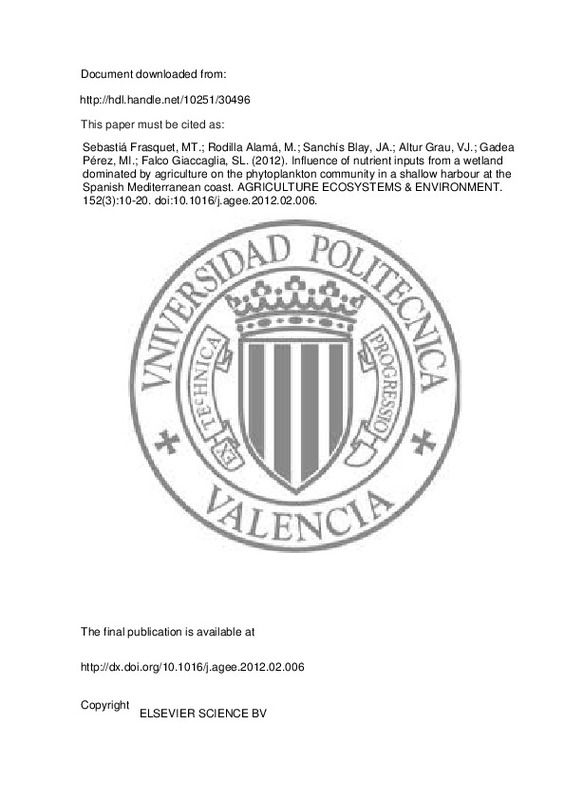Sebastiá Frasquet, MT.; Rodilla Alamá, M.; Sanchís Blay, JA.; Altur Grau, VJ.; Gadea Pérez, MI.; Falco Giaccaglia, SL. (2012). Influence of nutrient inputs from a wetland dominated by agriculture on the phytoplankton community in a shallow harbour at the Spanish Mediterranean coast. AGRICULTURE ECOSYSTEMS & ENVIRONMENT. 152(3):10-20. doi:10.1016/j.agee.2012.02.006
Por favor, use este identificador para citar o enlazar este ítem: http://hdl.handle.net/10251/30496
|
Título:
|
Influence of nutrient inputs from a wetland dominated by agriculture on the phytoplankton community in a shallow harbour at the Spanish Mediterranean coast
|
|
Autor:
|

 Sebastiá Frasquet, María Teresa
Sebastiá Frasquet, María Teresa

 Rodilla Alamá, Miguel
Rodilla Alamá, Miguel
 Sanchís Blay, José Andrés
Sanchís Blay, José Andrés

 Altur Grau, Vicent Jesús
Gadea Pérez, María Isabel
Altur Grau, Vicent Jesús
Gadea Pérez, María Isabel

 Falco Giaccaglia, Silvia Laura
Falco Giaccaglia, Silvia Laura
|
|
Entidad UPV:
|
Universitat Politècnica de València. Departamento de Urbanismo - Departament d'Urbanisme
Universitat Politècnica de València. Departamento de Ingeniería Hidráulica y Medio Ambiente - Departament d'Enginyeria Hidràulica i Medi Ambient
Universitat Politècnica de València. Instituto de Investigación para la Gestión Integral de Zonas Costeras - Institut d'Investigació per a la Gestió Integral de Zones Costaneres
|
|
Fecha difusión:
|
|
|
Resumen:
|
[EN] The Safor Wetland (Western Mediterranean) is a protected ecosystem declared Site of Community Importance under the Habitats Directive. Agricultural practices have been part of this ecosystem throughout history, and ...[+]
[EN] The Safor Wetland (Western Mediterranean) is a protected ecosystem declared Site of Community Importance under the Habitats Directive. Agricultural practices have been part of this ecosystem throughout history, and its hydrology is anthropogenically manipulated to satisfy cultivation needs. Freshwater from the wetland is discharged through surface channels to Gandia Harbour, a shallow water body with high water residence time. This study evaluated the linear eutrophication gradient downstream from the freshwater inflow locations. The role of the main nutrients in determining the phytoplankton community is discussed. The predominance of agricultural practices, 48% of the watershed soil, caused an excess of nitrogen and an imbalance in the nutrient ratios at all the sampling points. Phosphorus concentrations were particularly low, and did not exceed 1.0 ¿M. Chlorophyll-a concentration was of the order of that found in other eutrophic estuarine waters. In general, flagellates dominated over diatoms at all the harbour sampling points and depths. Potentially blooming species of both phytoplankton groups were detected. The correct implementation of the existing agricultural best management practices should continue to reduce nitrogen and phosphorus loading to the estuary. It seems reasonable that for effective control of the eutrophication effects in this area, strict control over wastewater point sources should be also exercised. © 2012 Elsevier B.V.
[-]
|
|
Palabras clave:
|
Agricultural runoff
,
CHEMTAX
,
Estuary
,
Eutrophication
,
Photosynthetic pigments
,
Western Mediterranean
,
Agricultural practice
,
Algal bloom
,
Anthropogenic effect
,
Best management practice
,
Chlorophyll a
,
Coastal zone
,
Concentration (composition)
,
Cultivation
,
Diatom
,
Discharge
,
Estuarine environment
,
Estuarine pollution
,
Flagellate
,
Harbor
,
Inflow
,
Mediterranean environment
,
Nitrogen
,
Nutrient availability
,
Phosphorus
,
Point source
,
Residence time
,
Shallow water
,
Wastewater
,
Watershed
,
Wetland
,
Comunidad Valencia
,
Gandia
,
La Safor
,
Spain
,
Valencia [Comunidad Valencia]
,
Bacillariophyta
,
Mastigophora (flagellates)
|
|
Derechos de uso:
|
Reserva de todos los derechos
|
|
Fuente:
|
AGRICULTURE ECOSYSTEMS & ENVIRONMENT. (issn:
0167-8809
)
|
|
DOI:
|
10.1016/j.agee.2012.02.006
|
|
Editorial:
|
ELSEVIER SCIENCE BV
|
|
Versión del editor:
|
http://dx.doi.org/10.1016/j.agee.2012.02.006
|
|
Tipo:
|
Artículo
|







![[Cerrado]](/themes/UPV/images/candado.png)


